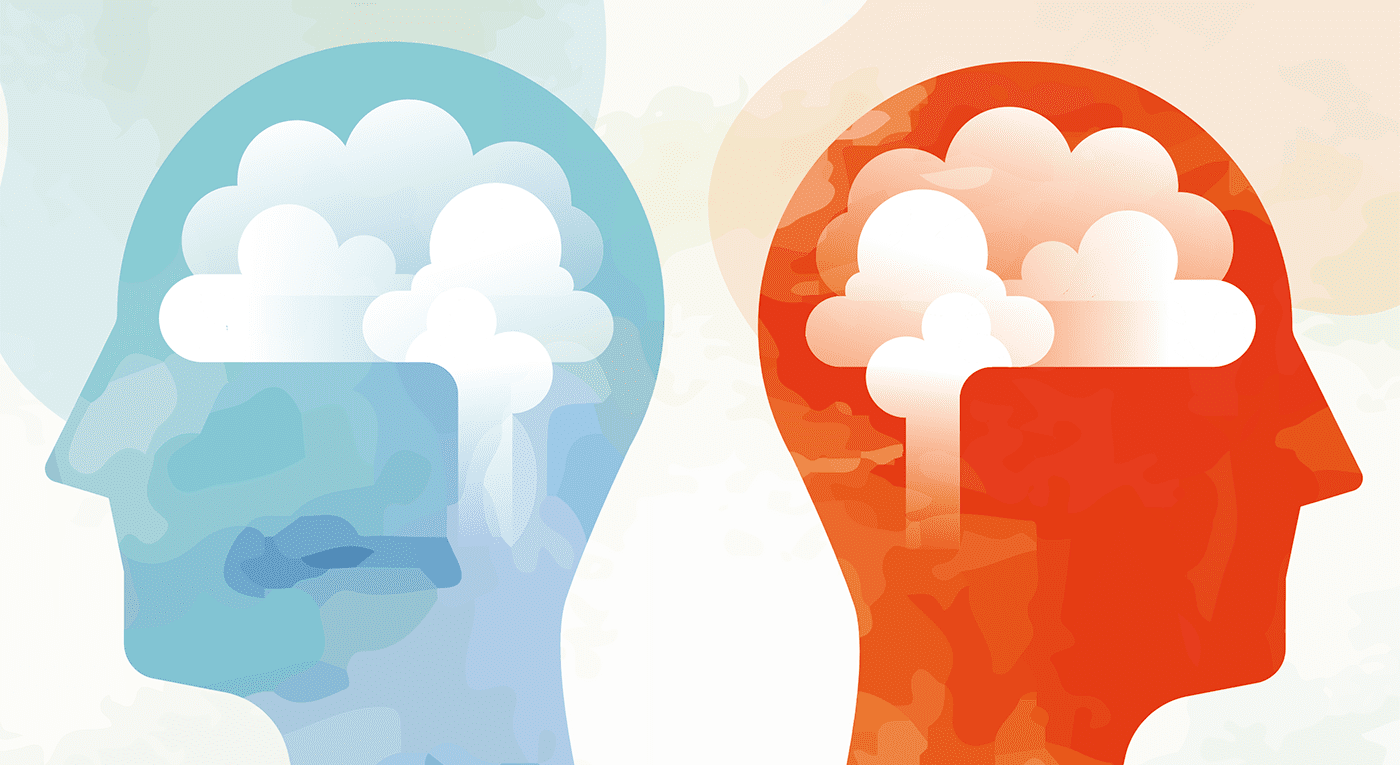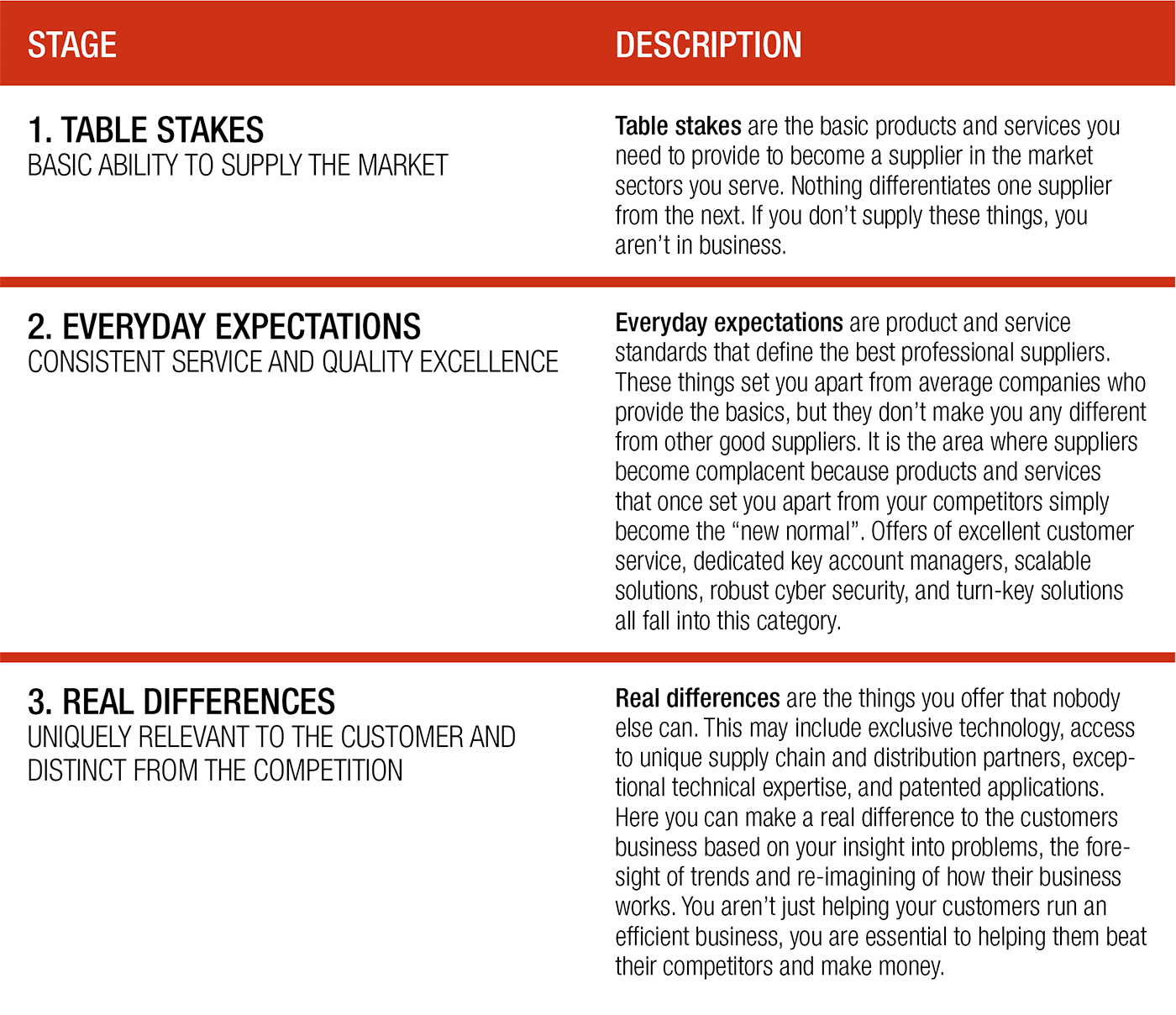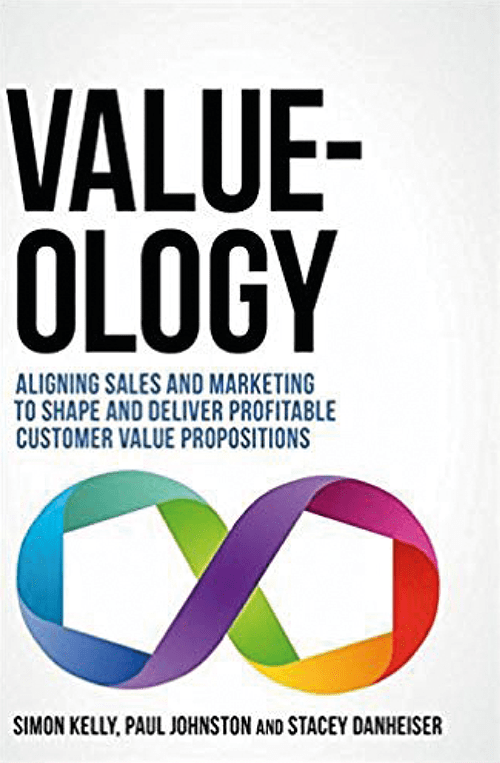Professional sales and the “differentiation conundrum”
12th December 2019 | Simon Kelly, Dr Paul Johnston and Stacey Danheiser
How salespeople can make a difference in helping their organisation stand-out from competitors, in ways that resonate with customers.
Article summary
This is the fourth in a series of articles in which Dr Simon Kelly, Dr Paul Johnston and Stacey Danheiser explore customer value and differentiation. Here they draw from their own recent research, to focus on the role that salespeople can play in helping their organisations differentiate and stand-out in a “sea of sameness”. The research will inform an upcoming book to be published as a follow up to Value-Ology: Aligning Sales and Marketing to Shape and Deliver Profitable Value Propositions (Kelly, Johnston, Danheiser 2017).
Their research programme centred around in-depth qualitative interviews with C-Level executives, sales and marketing leaders, asking them to consider competitive advantage, the roles of sales and marketing in creating differentiation, and the personal competencies required to help an organisation stand out. In addition, they developed a survey which went out to a wider audience of sales and marketing professionals. In parallel they compared websites and Twitter feeds for the top 30 players in three sectors: telecoms, data centres, and higher education. What they discovered led them to publish a series of white papers entitled “Swimming in a sea of sameness” because all the organisations were saying exactly the same things as each other, leaving the customer “Swimming in a sea of sameness”. In this piece, they focus on how salespeople can make a difference in helping their organisation stand-out from competitors, in ways that resonate with customers.

In our book Value-ology (Kelly, Johnston and Danheiser 2017), we drew attention to Qvidian’s research that showed 58% of deals end up in no decision because the customer has not been convinced of the value being offered, which means your biggest competitor is inertia. Our own “Sea of Sameness” research found that organisations in the three sectors we investigated were all saying the same things. They make generic “why us” claims and inside-out statements that simply talk about the company rather than the customer’s problems and aims.
When customers find it hard to choose between one supplier and another, sales suffer – demonstrated by the fact that only 57% of sales reps are making their quota (All that Glitters is Not Gold, CSO Insights 2019).
So, why is this “sameness” epidemic happening? how you can tell if your organization is differentiated? and what you can do to stand out from a sales perspective?
Seven key factors lead to sameness
We recently interviewed and surveyed senior sales, marketing and business leaders to find out why they believe differentiation is hard to achieve. Based on their feedback, we discovered that there are seven key factors that lead to sameness:
1 Differentiation is hard
Overwhelmingly what we heard was that differentiation can be difficult, in more than one way: firstly, finding something that truly sets you apart in a way that is meaningful to customers and, secondly, expressing the differentiator clearly to succinctly to customers.
Terry, CEO of a European Telco said: “Because it’s hard I probably talk about this more than anything else. I wanted to write you a short letter, but I didn’t have time, so I wrote you a long one.”
He went on to say that, if you’re not prepared to really work at defining what your superiority is or why customers should be buying from you and what your long-term sustainable competitive advantage is, then “articulating that expressly with great clarity is really hard, because you haven’t actually gotten an answer to the question of what makes your better than competitors”.
You must also recognize that value is made up of a very diverse range of factors that vary in importance in different sectors, between different customers, and that value can change depending on the situation the customer finds themselves in.
2 The comfort blanket of success
When you’ve been successful with one approach, you naturally get complacent and think “why should we change now?” But success dulls motivation and gives companies a false sense of confidence related to their ability to keep winning.
As Norman, Head of Marketing at a Global Telco, said, “Almost all the lessons are learned the hard way. When things are going well, people just cruise along, and don’t ask themselves why it’s going well. They only ask themselves “why” when things go badly wrong.”
3 Fear of trying something new
B2B companies are often skipping real customer, market and competitor research, operating with the belief that “we already know everything”. This attitude leads to an incomplete understanding of what customers value is – especially in fast-moving, constantly evolving industries.
After failing at numerous rebranding campaigns, Wilson (CMO of a small cable operator) realized that they needed another perspective. “What I learned was that it’s difficult to see yourself clearly. You’re in the weeds and surrounded by thousands of opinions.”
4 Inexperienced management
Naïve organizations adopt the philosophy “if it worked for the competition, it will work for me.” But this rarely pays off.
As Robson, Global telco president said, “If at the leadership level across sales and marketing, they don’t have the wherewithal to truly fish out the differential story board, then the easiest default is to make sure that you’ve at least got a parity message out there.”
5 Inward-looking teams
So much effort goes into making sure the product/technology works well. As a result, organizations often fall in love with their products and become enamoured with what they’re building. They lose sight of whether or not their solution is completely relevant to the customer and is materially different than a competitor’s.
As Smith, VP Marketing for a Global telco said, “There’s so much effort that goes into the engineering of new products, that you kind of sort of collapse at the end of the finish line and maybe you haven’t really thought through the whole way along.”
6 Being locked in the organization’s mindset
Organizations get stuck when they can’t escape the beliefs and assumptions they have about markets, customers and competitors, and the way their business works. This can be often be driven by leadership, as Robson, President of a Global Telco, said: “If the Chief Executive isn’t bought into customer value and can understand it then you are destined to swim in a sea of sameness.”
Quite a long-standing issue in technology is that the CIO or the CTO are the buyers, so it’s ok to talk technical. While there is still a place for that view there is no doubt that a large percentage of purchases are now driven by other departments, like Marketing and Sales, who see what differentiates you as what you can bring in market share or new sales.
7 Laziness
Let’s face it, creating and communicating differentiation is hard. It impacts many areas of the business: product, marketing, sales, customer service, operations, billing and more. Mature B2B companies aren’t investing the time, energy or resources to truly understand what will differentiate them in the eyes of the customer.
It’s also a lot safer and easier to copy what your competitors are doing. When everyone in the industry is using the same jargon and messages, leadership tends not to question the approach. As Robson, former Telco President, told us, “I think generally people don’t have the depth of competitive intelligence to truly know what’s different or not from their offerings.”
Is what you’re selling differentiated?
Many businesses think they stand out from their competitors, but all the customer sees are similarities. You can only stand out in the market when you create value propositions that have differences from the customers’ point of view.
To understand if your offer is really different than your competitors, you need to think of it being made of three elements based on Ted Levitt’s 1980s idea of differentiation (Figure 1).

Salespeople play a critical role
Based on this chart, you may be thinking: “Great. We are at the table stakes level. There’s no hope!” But sales professionals play a central role in differentiating how your company, brand and solutions stand apart from your competitors in a way that is valued by the customer.
Why? As Rainey, President of an Integrated Software company, says, “Differentiation is not just what you sell but how you sell it. Get the best and most capable people you can to be able to understand the impact of your solution in business rather than the bits and bobs of the feature set.”
Sales professionals embody the company they work for and the solutions they offer. Whilst the term “rep” might seem rather old-fashioned and possibly derogatory, the essence of the idea of representation is very important in this context. Sales professionals represent every aspect of the company’s offer to the customer. They are the human side of price, product, brand and the customer experience; it is this boundary-spanning role between the customer and company that places the sales professional in a key feedback and feed-forward role when managing differentiation.
Without sales insight into customer reactions and responses to price positions, solution relevance, brand positioning and messages and service experience, the company is essentially flying blind.
The foundation of competitive differentiation and sustained competitive advantage can only come from providing solutions that your customers value. This is a deceptively simple problem to solve.
The challenge lies in your ability to understand what your customer needs, wants and, ultimately, what they are willing to pay for. You must also recognize that value is made up of a very diverse range of factors that vary in importance in different sectors, between different customers, and that value can change depending on the situation the customer finds themselves in.
At a time when only one in three buyers said that one vendor outshines the rest when making a purchase, the sales experience matters more than ever (CSO Insights).
Ways to make a difference
Think about your impact to make a difference in:
Personal face-to-face interactions with customers.
In research performed by the Corporate Executive Board around the time of publication of The Challenger Sale, customers said that they were almost three times more likely to be influenced by insights provided by salespeople rather than the brand. In B2B organisations we prefer to see salespeople as the manifestation of the brand; this can begin by having more positive personal dialogue with the customer at the front end of the sales process.
Ken, Owner of a B2B training company, pointed out: “If there are two training providers meeting the same MD of a potential customer, I would wager that within five minutes I’m still listening to his stories, becoming super-interested, showing empathy and enjoying the conversation. Salesperson number two would be already telling them about their products, talking about themselves.
The problem-recognition and solving experience customers get.
Buyers don’t necessarily know what they need. Sales plays a critical role in offering insights and helping the customer clarify both their problem and the options they have to solve it. In fact, Aberdeen found that this involves asking more questions, actively listening and offering new ways to think about the problems facing your customers. While this may seem obvious, sales reps are not delivering, as 97% of respondents in a recent Aberdeen study said that they want sales reps that can demonstrate a stronger knowledge of their company and needs (Aberdeen, “Why do B2B Buyers Struggle? The answer is in the data”).
Difference in style of collaborative engagement
In B2B selling, collaboration builds from the opening discussions and being in the 3% of salespeople that do strive to understand the customer to enable them to offer them something that connects to a key need. Herbert, Vice President of Sales at a Mobile phone company, pointed to listening as an enabler for collaboration: “I think it’s very much about listening to people, giving them an opportunity to talk about what their requirements are or what their need is, personal or institutional, and being able to translate this back to what you can offer, before collaborating on the best solution.”
Difference embedded in trust building interactions between people
As Zig Ziglar says, “If people like you, they’ll listen to you. But if they trust you, they’ll do business with you.” Listening goes a long way in building that trust.
According to a LinkedIn survey, B2B buyers are five times more likely to engage with a sales rep who provides new insights. This is only possible when the salesperson is actively listening – and not simply waiting for the buyer to finish speaking or thinking about what to say next. In the era of the internet and social media, listening also involves picking up the digital breadcrumbs that a buyer may have left – such as a tweet, Facebook post or a blog –to understand their current situation and challenges.

Close the loop
And finally, close the cohesive loop for competitive advantage. In the concluding chapter of our book Value-ology we speculated that “Cohesion is the new differentiator”. What we meant was that organisations which had a better feedback loop back from sales and customers into marketing could set themselves apart.
Our research really has affirmed this. If organisations are all saying the same things to customers, then making sense of what is coming out of the hundreds of daily sales calls and then reshaping value propositions in line with what customers want helps your organisation stand-out. Anyway, why would you want to put up with “sameness” marketing; make time to tell them what customers really see as meaningful difference.
Bibliography
Anderson J C and Narus J A, (1998) “Business marketing: understand what customer’s value”, Harvard Business Review (November–December), 76 (6), 53–65.
Sharp, B (2008) “Differentiation vs Distinctiveness”. Marketing Science blog,
https://byronsharp.wordpress.com/2008/04/10/differentiation-vs-distinctiveness/
Canon and Homburg (2001) “Buyer- Supplier Relationships and Customer Firm Costs”, Journal of Marketing, 65 (January), 29-43.
Kelly Johnston Danheiser (2017) Lost in a sea of sameness. https://www.shakemktg.com/lost-sea-sameness
Levitt T (1980), “Marketing success through the differentiation of anything”, Harvard Business Review.





